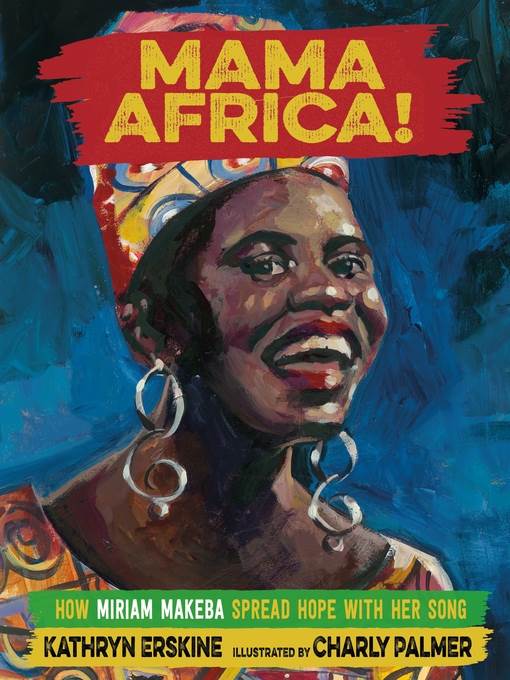
Mama Africa!
How Miriam Makeba Spread Hope with Her Song
فرمت کتاب
ebook
تاریخ انتشار
2017
Lexile Score
630
Reading Level
2-3
ATOS
3.9
Interest Level
K-3(LG)
نویسنده
Charly Palmerشابک
9781466897465
کتاب های مرتبط
- اطلاعات
- نقد و بررسی
- دیدگاه کاربران
نقد و بررسی

September 1, 2017
Gr 2-5-Miriam Makeba was a South African singer who used her talent to challenge apartheid and to encourage South Africans to rail against injustice. Early in her career, Makeba decided to sing in Setswana, IsiXhosa, and IsiZulu precisely because the white ruling class did not speak those languages. A sense of rising tension is unmistakable throughout the text, and each of Makeba's hopeful successes is followed by further struggle, finally culminating in Nelson Mandela's release from prison and the slow end of apartheid in South Africa. Debut illustrator Palmer's painterly spreads shine in rich colors and bold brushstrokes, capturing the passion of Makeba mid-song. In other spreads, scenes of an armed white police officer demanding the transit pass of a black man who has stepped outside of his neighborhood boundary, and a lone child who has survived the massacre of school children at Soweto, all speak acutely to the landscape of apartheid that shaped Mama Africa's career. Erksine spent some of her childhood living in apartheid South Africa, and she shares her own experiences and connection to Makeba's music at length in the back matter. VERDICT A welcome addition to picture book biography collections.-Lauren Younger, New York Public Library
Copyright 2017 School Library Journal, LLC Used with permission.

August 15, 2017
Buoyed by the work of Nelson Mandela and the music of Billie Holiday and Ella Fitzgerald, Miriam sang to make black South Africans free.Born in 1932 near Johannesburg, Miriam Makeba "sang as soon as she could talk." Growing up in apartheid-era South Africa, she rebelled against unjust laws restricting where blacks could go and what they could do, and she fought that racism with her songs, even singing subversively in languages the government officials could not understand. Eventually, Miriam illegally left South Africa to sing internationally and tell the world that blacks were dying because of apartheid. Throughout the book, white rectangular text boxes convey the discriminatory actions of the baases (white ruling class), while black-backgrounded text boxes present Makeba's words and efforts to fight racism--making white negative and black positive. Palmer's densely illustrated, painterly scenes give readers a strong sense of the culture and beauty of South Africa. His images of people, however, often include just enough detail to reveal their emotions. The backmatter offers a single timeline of Makeba's life and the U.S. civil rights movement, a glossary, and copious research resources. Erskine, a white woman who, as a child, lived in South Africa during apartheid, includes photos of her young self working for social justice. An excellent perspective from which American readers can learn about apartheid and one of the pioneers who fought it through her art. (Picture book/biography. 6-10)
COPYRIGHT(2017) Kirkus Reviews, ALL RIGHTS RESERVED.

Starred review from October 9, 2017
National Book Award–winner Erskine (Mockingbird) takes readers to the South Africa of her childhood as she follows the rise of singer/activist Miriam Makeba. The injustice of apartheid, omnipresent in Makeba’s life, extends into the book’s design: sections of text about the white “baases” in power appear in white boxes, while passages about Makeba and anti-apartheid movements are set in separate black boxes: “She sings to her people to be brave. ‘Jolinkomo!’ She sings of police raids. ‘Khawuleza!’ ” In his first children’s book, Palmer uses thick, forceful brushstrokes to create vibrant, abstracted portraits of Makeba and her South African home. This rousing account of how Makeba used her music to fight for equality concludes with a timeline and extensive author’s note. Ages 6–10. Author’s agent: Kendra Marcus, Bookstop Literary.

September 15, 2017
Grades 2-4 This picture-book biography of Miriam Makeba shows how she used her voice, both spoken and in songs of protest, to raise awareness and help fight the system of apartheid in her native South Africa. Makeba spent her life in the effort of heightening understanding of and bringing an end to institutionalized segregation thrust upon African ethnic groups between 1948 and the early 1990s. Palmer's striking, boldly colored illustrations reveal both movement and mood while adeptly revealing the story of Makeba's life. The text is printed on wide strokes of alternating black and white paint, using the opposite color of ink on each. Some wordsbrave, voice, anger, watch, bewareare printed in red ink, which is more puzzling than impactful. Back matter includes an author's note, a selected bibliography, and a glossary. Notable freedom fighters Nelson Mandela and Martin Luther King Jr. are mentioned here, but this accessible biography will introduce children to a woman whose lifelong dedication to the abolishment of an unjust system made a difference.(Reprinted with permission of Booklist, copyright 2017, American Library Association.)

























دیدگاه کاربران